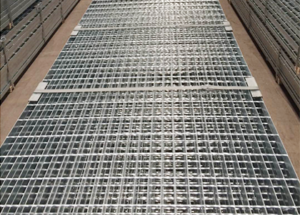Steel grating is a type of metal grating that is commonly used for flooring, stair treads, and catwalks. It is made from a series of parallel, elongated bars that are attached to perpendicular crossbars to form a sturdy and open grid pattern. The material used for steel grating can vary depending on the application and environmental conditions.
One of the most common materials used for steel grating is carbon steel. Carbon steel steel grating offers high strength and durability, making it suitable for heavy-duty applications. It is also cost-effective and easy to fabricate, making it a popular choice for many industrial and commercial settings.

Stainless steel is another popular material for steel grating. It offers excellent corrosion resistance, making it ideal for outdoor or corrosive environments. Stainless steel steel grating is also known for its sleek appearance and low maintenance requirements, making it a versatile choice for various architectural and industrial applications.
Aluminum steel grating is lightweight yet strong, making it an ideal choice for applications where weight is a concern. It also offers good corrosion resistance and is often used in architectural and decorative applications. Aluminum steel grating is available in various alloy grades to suit different environmental conditions.
Fiberglass reinforced plastic (FRP) steel grating is a durable and lightweight alternative to traditional metal grating. It is non-conductive, making it suitable for electrical and telecommunications applications. FRP steel grating is also resistant to chemicals and UV exposure, making it a long-lasting choice for harsh environments.
Other materials used for steel grating include galvanized steel, which is coated with a layer of zinc for corrosion resistance, and copper, which offers antimicrobial properties. Each material has its own unique characteristics and advantages, allowing for customization based on specific project requirements.

